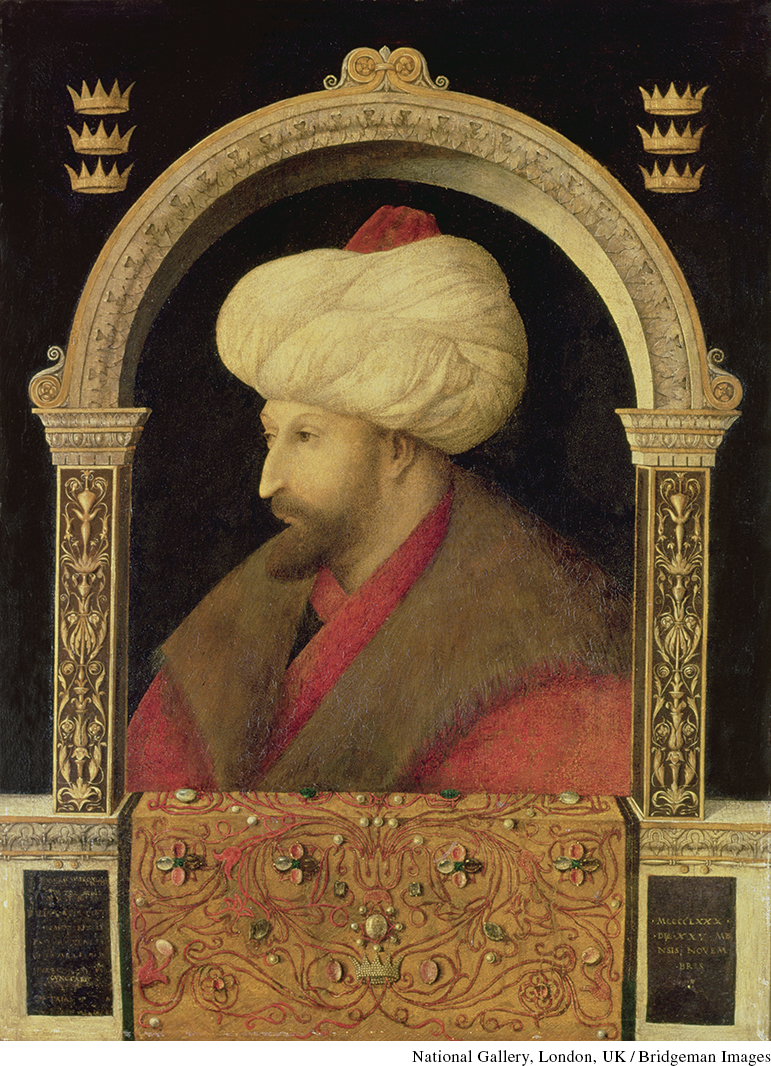Introduction for Chapter 13

IN 1453, THE OTTOMAN TURKS turned their cannons on Constantinople and blasted the city’s walls. The fall of Constantinople, which spelled the end of the Byzantine Empire, was an enormous shock to Europeans. Some, like the pope, called for a crusade against the Ottomans; others, like the writer Lauro Quirini, sneered, calling the Ottomans “a barbaric, uncultivated race, without established customs, or laws, [who lived] a careless, vagrant, arbitrary life.”
But the Turks didn’t consider themselves uncultivated or arbitrary. They saw themselves as the true heirs of the Roman Empire, and they shared many of the values and tastes of the very Europeans who were so hostile to them. Sultan Mehmed II employed European architects to construct his new palace—the Topkapi Saray—in the city once known as Constantinople and now popularly called Istanbul. He commissioned the Venetian artist Gentile Bellini to paint his portrait, a genre invented in Burgundy to celebrate the status and individuality of important and wealthy patrons.
Mehmed’s actions sum up the dual features of the period of crisis and Renaissance that took place from the middle of the fourteenth century to the late fifteenth century. What was a crisis from one point of view—the fall of the Byzantine Empire—was at the same time stimulus for what historians call the Renaissance. Both to confront and to mask the crises of the day, people discovered new value in ancient, classical culture; they created a new vocabulary drawn from classical literature as well as astonishing new forms of art and music based on ancient precedents. The classical revival provided the stimulus for new styles of living, ruling, and thinking.
CHAPTER FOCUS Who suffered and who benefited from the events of the period from 1340 to 1492?
Along with the fall of the Byzantine Empire, other crises marked the period from 1340 to 1492. These were matched by equally significant gains. The plague, or Black Death, tore at the fabric of communities and families; but the survivors and their children reaped the benefits of higher wages and better living standards. The Hundred Years’ War, fought between France and England, involved many smaller states in its slaughter and brought untold misery to the French countryside; but it also helped create the glittering court of Burgundy. By the war’s end, both the French and the English kings were more powerful than ever. Following their conquest of Constantinople, the Ottoman Turks penetrated far into the Balkans; but this was a calamity only from the European point of view. Well into the sixteenth century, the Ottomans were part of the culture that nourished the artistic achievements of the Renaissance. A crisis in the church overlapped with the crises of disease and war as a schism within the papacy—pitting pope against pope—divided Europe into separate camps. But a church council whose members included Renaissance humanists eventually resolved the papal schism by reestablishing the old system: a single pope who presided over the church from Rome.